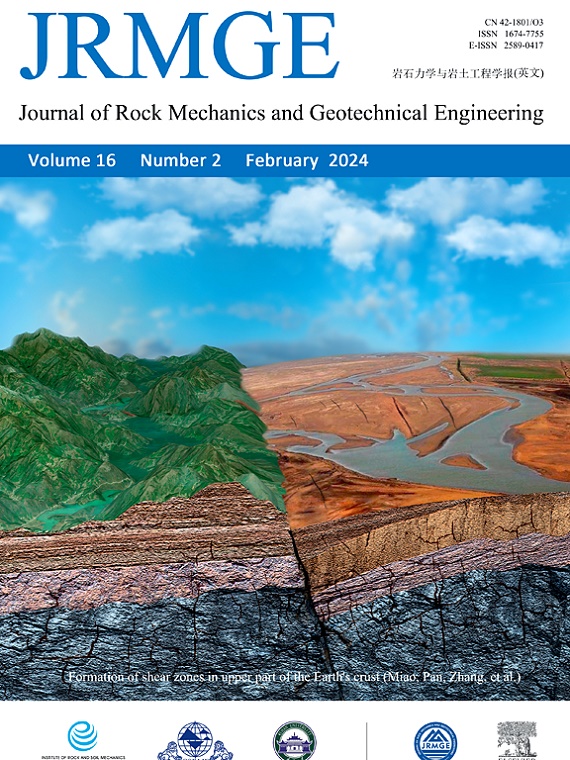Digital monitoring of rotary-percussive drilling with down-the-hole hammer for profiling weathered granitic ground
IF 10.2
1区 工程技术
Q1 ENGINEERING, GEOLOGICAL
Journal of Rock Mechanics and Geotechnical Engineering
Pub Date : 2023-11-01
DOI:10.1016/j.jrmge.2023.08.006
引用次数: 0
Abstract
Rock and geotechnical engineering investigations involve drilling holes in ground with or without retrieving soil and rock samples to construct the subsurface ground profile. On the basis of an actual soil nailing drilling for a slope stability project in Hong Kong, this paper further develops the drilling process monitoring (DPM) method for digitally profiling the subsurface geomaterials of weathered granitic rocks using a compressed airflow driven percussive-rotary drilling machine with down-the-hole (DTH) hammer. Seven transducers are installed on the drilling machine and record the chuck displacement, DTH rotational speed, and five pressures from five compressed airflows in real-time series. The mechanism and operations of the drilling machine are elaborated in detail, which is essential for understanding and evaluating the drilling data. A MATLAB program is developed to automatically filter the recorded drilling data in time series and classify them into different drilling processes in sub-time series. These processes include penetration, push-in with or without rod, pull-back with or without rod, rod-tightening and rod-untightening. The drilling data are further reconstructed to plot the curve of drill-bit depth versus the net drilling time along each of the six drillholes. Each curve is found to contain multiple linear segments with a constant penetration rate, which implies a zone of homogenous geomaterial with different weathering grades. The effect from fluctuation of the applied pressures is evaluated quantitatively. Detailed analyses are presented for accurately assess and verify the underground profiling and strength in weathered granitic rock, which provided the basis of using DPM method to confidently assess drilling measurements to interpret the subsurface profile in real time.风化花岗岩地层钻孔锤式旋转冲击钻井的数字监测
岩石和岩土工程调查包括在地面上钻孔,有或没有提取土壤和岩石样本来构建地下地面剖面。本文以香港某边坡稳定工程的实际土钉钻孔为基础,进一步发展了利用压缩气流驱动的钻孔锤式冲击旋转钻机对风化花岗岩地下地质物质进行数字剖面的钻孔过程监测方法。钻床上安装了7个传感器,可以实时记录卡盘位移、潜孔转速和5种压缩气流的5种压力。详细阐述了钻机的工作原理和操作方法,这对理解和评价钻井数据至关重要。开发了一个MATLAB程序,对记录的钻井数据进行时间序列的自动过滤,并在子时间序列中将其划分为不同的钻井过程。这些过程包括钻进、带或不带抽油杆的推入、带或不带抽油杆的拉回、抽油杆拧紧和松开。进一步重建钻井数据,绘制出沿6个钻孔的钻头深度与净钻井时间的曲线。每条曲线都包含多个具有恒定渗透率的线性段,这意味着一个具有不同风化等级的均匀土质区域。对施加压力波动的影响进行了定量评价。为准确评估和验证风化花岗岩的地下剖面和强度提供了详细的分析,为利用DPM方法自信地评估钻井测量数据,实时解释地下剖面提供了依据。
本文章由计算机程序翻译,如有差异,请以英文原文为准。
求助全文
约1分钟内获得全文
求助全文
来源期刊

Journal of Rock Mechanics and Geotechnical Engineering
Earth and Planetary Sciences-Geotechnical Engineering and Engineering Geology
CiteScore
11.60
自引率
6.80%
发文量
227
审稿时长
48 days
期刊介绍:
The Journal of Rock Mechanics and Geotechnical Engineering (JRMGE), overseen by the Institute of Rock and Soil Mechanics, Chinese Academy of Sciences, is dedicated to the latest advancements in rock mechanics and geotechnical engineering. It serves as a platform for global scholars to stay updated on developments in various related fields including soil mechanics, foundation engineering, civil engineering, mining engineering, hydraulic engineering, petroleum engineering, and engineering geology. With a focus on fostering international academic exchange, JRMGE acts as a conduit between theoretical advancements and practical applications. Topics covered include new theories, technologies, methods, experiences, in-situ and laboratory tests, developments, case studies, and timely reviews within the realm of rock mechanics and geotechnical engineering.
 求助内容:
求助内容: 应助结果提醒方式:
应助结果提醒方式:


